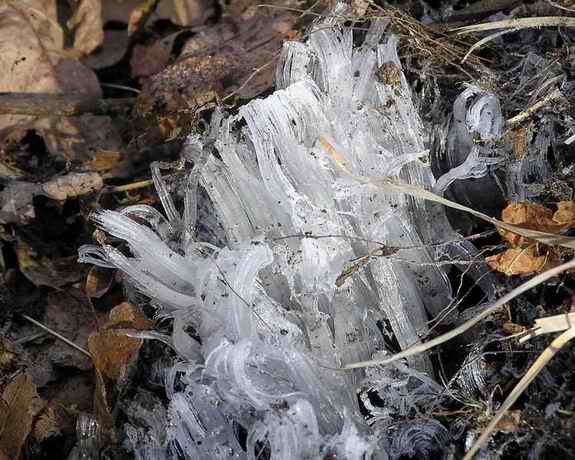|
Return to Hiker's Notebook Home Page
Needle ice is the name most commonly given to the ice formation that has a characteristic filamentous appearance with individual needles extending independently and in fascicular bundles. As there is no sanctioned definition for the phenomenon, it has many colloquial names that metaphorically describe its prominent features. These names include ice castles, frost castles, ice fringes, ice filaments, ice flowers, ice ribbons, frost flowers, and rabbit ice. Unabridged dictionaries contain entries for needle ice, referring to frazil, ice crystals resembling slush that form in supercooled water that are prevented from coalescing by turbulence. To add more confusion to the semantics, ice needles are slender ice particles that float in the air in clear, cold weather.
The physics of needle ice formation is well understood and relatively simplistic. The fundamental requirement for its creation is the presence of flowing, unfrozen ground water that contacts air that is below freezing. The long, extruded shapes are the result of the continuous hydrostatic pressure of the ground water that forces the ice upward into the air, where it freezes into needle-like columns. Needle ice is found in areas that have the requisite geological attributes when appropriate environmental conditions prevail. Seeping ground water is usually found on sloping ground where the artesian well effect of the terrain provides the requisite hydrostatic pressure. This is generally found in areas that have slopes that are have a grade of about 60 degrees. It normally forms over night when the air temperature drops sufficiently to provide the thermal gradient for ice formation. Needle ice formed in this manner is normally about an inch long, but it can grow to as long as a foot under ideal circumstances.
Experimentation in laboratories has confirmed the underlying physical properties that engender needle ice. In a 1989 paper in the Journal of Colloid and Interface Science entitled "Segregated Ice Growth on a Microporous Filter," ice segregation was defined as "the phenomenon in which, through freezing, ice grows out from moisture containing porous material such as soil." It was determined that the liquid from which the surface ice was formed was supercooled, a phenomenon in which very pure H2O can exist in liquid form below the freezing point in the absence of nucleation sites for the initiation of ice formation. It was concluded that the experimental process replicated the formation of needle ice in loose soils.
The formation of needle ice structures is a well-recognized phenomenon in areas with the necessary and sufficient environmental conditions; it is called kammeis in Germany, pipkrake in Sweden and shimobashira in Japan. The German name kammeis translates to "comb ice" as the structure suggests the teeth of a hair comb. It occurs on sloped regions to the extent that a special name ,kammeissolifluktion, is given to the process of movement of soil down the face of a slope due to comb ice. The Swedish name pipkrake is used largely in reference to sub-arctic needle ice. Pipkrake formation results in frost creep, one of the primary geomorphologic processes associated with the shift of temperature across the freezing point of water. Frost creep occurs in permafrost regions due to the action of the individual pipkraken (needles) that rise beneath individual sediment particles. The net movement of soil due to needle ice/pipkrake is up to one meter per year; laboratory demonstrations have shown that pipkrake can lift ten pound rocks. The Japanese word for needle ice, shimobashira, translates as "columns of frost."
The formation of ice structures that resemble flowers or ribbons is due to a freezing phenomenon that is closely related to that which causes needle ice. The fundamental difference is that ice flowers exude from the stems of certain plants whereas needle ice exudes from ground water without any botanical conduit. The geometry of certain plants and rotting wood is such that a passage for supercooled water is created. When the temperature drops, longitudinal cracks form along the axis of the stem and allow the liquid to ooze out into sub-zero air to be almost instantaneously frozen into a ribbon-like crispation. The overpressure that pushes the extruded ribbon out is thought to be the result of the gradual freezing of the water in the stem. Ice flower formation is often erroneously attributed to frozen sap, which may contribute to the cracking of the stem wall. However, there is not enough sap in the plant to create the "remarkable accumulations of voluminous friable masses of semi-pellucid ice around the footstalks of the Pluchea which grow along the road-side ditches" as described by Dr LeConte of the University of Georgia in 1850. The plants that exhibit ice flower formation have been identified by observation, as the relevant dimensions of the plants' structures that result in the phenomenon have not yet been determined. The list, largely anecdotal includes: dittany (Cunila origanoides), frostweed (Helianthemum canadense), yellow ironweed (Verbesina alternifolia) and white crownbeard (Verbesina virginica). |
